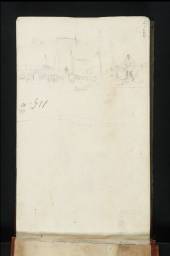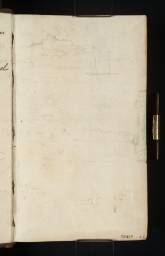Tour of the Netherlands, Germany, Belgium and the French Coast; Kent Subjects for ‘Picturesque Views on the Southern Coast’ 1825
From the entry
Beginning around the end of August, the Holland and Holland, Meuse and Cologne sketchbooks were principally used for a few weeks in the early autumn of 1825 during a tour around what are today the Netherlands (often historically and colloquially ‘Holland’) including Rotterdam and Amsterdam, Germany up the River Rhine to Cologne, Belgium by way of Liège and Antwerp, and the coast of France to Boulogne, along a clockwise route with a long western extension amounting to something like six hundred miles. Holland and Belgium at that time formed the post-Napoleonic United Kingdom of the Netherlands, with which Luxembourg was also affiliated. Turner used the two sketchbooks simultaneously, all but filling the central four fifths of the compact, leather-bound Holland book (of nearly three hundred leaves overall) while using most of the ninety or so leaves of the larger quarter-bound Holland, Meuse and Cologne more selectively. Only seven cities (Rotterdam, Amsterdam, Düsseldorf, Cologne, Liège ...
Holland, Meuse and Cologne Sketchbook 1818, 1825
D19401–D19454, D19456–D19467, D19482–D19542, D19546–D19551, D41011–D41013 Turner Bequest CCXV 1–90a
D19401–D19454, D19456–D19467, D19482–D19542, D19546–D19551, D41011–D41013 Turner Bequest CCXV 1–90a
References
Beginning around the end of August, the Holland and Holland, Meuse and Cologne sketchbooks were principally used for a few weeks in the early autumn of 1825 during a tour around what are today the Netherlands (often historically and colloquially ‘Holland’) including Rotterdam and Amsterdam, Germany up the River Rhine to Cologne, Belgium by way of Liège and Antwerp, and the coast of France to Boulogne, along a clockwise route with a long western extension amounting to something like six hundred miles. Holland and Belgium at that time formed the post-Napoleonic United Kingdom of the Netherlands, with which Luxembourg was also affiliated.
Turner used the two sketchbooks simultaneously, all but filling the central four fifths of the compact, leather-bound Holland book (of nearly three hundred leaves overall) while using most of the ninety or so leaves of the larger quarter-bound Holland, Meuse and Cologne more selectively. Only seven cities (Rotterdam, Amsterdam, Düsseldorf, Cologne, Liège, Maastricht and Boulogne) are included there, albeit in considerable detail, and all are complemented by other sketches among the many more sites covered by its smaller companion. Together they comprise the only direct evidence of the tour, apart from Turner’s professed decision to embark on it shortly beforehand as set out in the Introduction to the Holland sketchbook; since the latter encompasses the entire journey, its immediate circumstances, full itinerary and outcomes, along with previous Turner scholars’ commentaries,1 are dealt with there in more detail.
The artist had visited Belgium, the Rhine south of Cologne and the Netherlands in 1817, on his first Continental tour in the wake of the Napoleonic Wars2 (followed by Italy in 1819–20 and France in 1821). A year before the present visit, he had explored the Rivers Meuse and Moselle on a route through Belgium and north-eastern France, Luxembourg, the second river as it continued into Germany as the Mosel, and the Rhine between Coblenz and Cologne (see Alice Rylance-Watson’s ‘Meuse-Mosel, Luxembourg and Northern France 1824’ section in the present catalogue). On both earlier occasions he passed through some of the places he revisited this time, and Cecilia Powell has noted that this time ‘it is probable that Turner deliberately followed his practice of 1824 in taking with him a small upright book ... for note-taking and smaller sketches and a larger horizontal one ... for more extensive views and more detailed studies’;3 compare respectively the previous year’s Rivers Meuse and Moselle and Huy and Dinant sketchbooks (Tate; Turner Bequest CCXVI, CCXVII).
Following a brief stay at Dieppe towards the end of the 1824 tour, Turner’s sole exhibit at the Royal Academy in the early summer of 1825 had been the major oil painting Harbour of Dieppe (Changement de Domicile) (Frick Collection, New York).4 Likewise, the only painting to result directly from the present tour would be Cologne, the Arrival of a Packet Boat, Evening, shown at the same venue in 1826 (also Frick Collection).5 They are of similar large sizes and loosely comparable in terms of their waterside settings and lambent atmosphere, and Dieppe had apparently been commissioned by the London collector John Broadhurst, but it is not clear that the same applied to Cologne, although he did later acquire it. This may account for Turner’s equally intensive study of numerous other waterside town and cities along his route; see the Introduction to the Holland sketchbook for further discussion.6
There are a few sketches at Dover in the Holland, Meuse and Cologne sketchbook, and more extensive sequences at both ends of the Holland book comprising coastal subjects there and elsewhere in Kent, but their relationship with the route to and from the Continent remains uncertain. Numerous sketches of Dover, Whitstable, Deal and Folkestone can be linked to watercolours engraved and published within a year for the last parts of the long-running Picturesque Views on the Southern Coast of England series. It is assumed for the purposes of the present catalogue that the Kent sketches were made in the same year as the Continental tour, likely immediately beforehand and afterwards.
It has been suggested that drawings at the front and back of the Thames sketchbook (Tate; Turner Bequest CCXII), in use around this time, were made on the tour.7 The sketches are mainly of figures and shipping, which might equally have been observed along the River Thames, and some indeed share pages with identified Thames subjects (Tate D18595, D18597–D18599, D18602, D18697, D18700–D18704, D40972; Turner Bequest CCXII 1, 2–3a, 5, 87, 89–91 and verso; and D40969 and D40973, inside the covers).
Later journeys through the region include those of 1833, 1835 and 1840, and in 1839 Turner undertook a second Meuse-Moselle tour, largely reprising the 1824 itinerary; all are addressed elsewhere in the present catalogue. This Introduction and many of the individual Dutch and Belgian entries are jointly signed by the Dutch art historian Quirine van der Meer Mohr (temporary Researcher on the Dutch and Belgian material in the Turner Bequest, on placement from the University of Utrecht in 2013–14) and Matthew Imms, who has subsequently expanded on her notes and suggestions, as well as addressing the tour’s English and German subjects.
Note: As explained in the Introduction to the Holland, Meuse and Cologne sketchbook, a leaf from a similar book used on Turner’s 1818 visit to Scotland has long been spuriously associated with it and remains bound there, accounting for the two dates applied to the book as a whole.
Including Finberg 1961, p.291, Lindsay 1966, p.164, Wilton 1987, p.166, Powell 1991, pp.44–5, 119, Bachrach 1994, p.19, Powell 1995, pp.33–4, Bailey 1997, pp.221–2, Hamilton 1997, p.255, Warrell 1997, p.17, Wilton 2006, p.236, Brown 2008, pp.25, 27, Warrell 214, p.138, and Moyle 2016, p.324.
See Powell 1991, pp.20–36, 189–202 for the most detailed published account; research for the present catalogue on the six associated Turner Bequest sketchbooks is ongoing.
Martin Butlin and Evelyn Joll, The Paintings of J.M.W. Turner, revised ed., New Haven and London 1984, pp.140–1 no.231, pl.234 (colour).
See ibid., pp.140–2, Powell 1991, pp.44, 45, 61 note 37, Powell 1995, pp.33–4, and Ian Warrell, Turner on the Loire, exhibition catalogue, Tate Gallery, London 1997, pp.172–181.
How to cite
Matthew Imms and Quirine van der Meer Mohr, ‘Tour of the Netherlands, Germany, Belgium and the French Coast; Kent Subjects for ‘Picturesque Views on the Southern Coast’ 1825’, September 2020, in David Blayney Brown (ed.), J.M.W. Turner: Sketchbooks, Drawings and Watercolours, Tate Research Publication, August 2023, https://www


